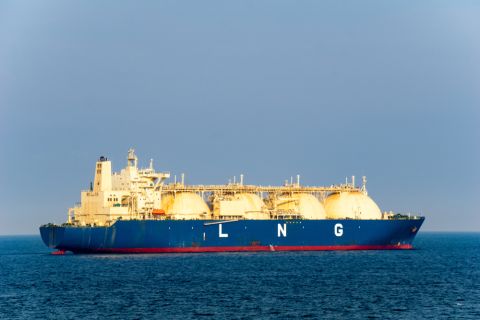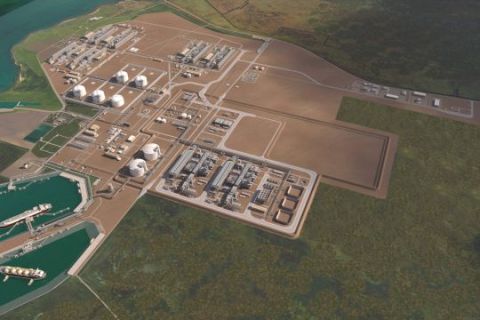U.S. natural gas futures rose about 3% to a five-week high on March 3, with the amount of gas flowing to U.S. LNG export plants set to hit a daily record high and on forecasts for colder weather and higher heating demand in two weeks than previously expected.
The amount of gas flowing to LNG export plants was on track to hit a daily record high as Freeport LNG's facility in Texas keeps pulling in more of the fuel after exiting an eight-month outage in February. The plant shut after a fire in June 2022.
Front-month gas futures for April delivery were up 6.9 cents, or 2.5%, to $2.834/MMBtu at 8:23 a.m. EST, putting the contract on track for its highest close since Jan. 27.
For the week, the front-month was up about 16%, which would be its biggest weekly gain since late July. It rose about 8% last week.
Freeport LNG's export plant was on track to pull in about 1.4 Bcf/d of gas on March 3, up from 1.2 Bcf/d on March 2, according to data provider Refinitiv, a sign the company likely started the second of three liquefaction trains at the plant. Liquefaction trains turn gas into LNG.
When operating at full power, Freeport LNG, the second-biggest U.S. LNG export plant, can turn about 2.1 Bcf/d of gas into LNG for export.
Freeport LNG said on Feb. 21 that it could be consuming about 2.0 Bcf/d of feedgas "over the next several weeks." Some analysts have said that Freeport LNG will likely not return to full capacity until the end of April.
Federal regulators have already approved the restart of two of Freeport LNG's three liquefaction trains (Trains 2 and 3). On Feb. 27, Freeport LNG asked regulators for permission to restart the third (Train 1).
The total amount of gas flowing to U.S. LNG export plants has risen to 13.4 Bcf/d so far in March from 12.8 Bcf/d in February. That compares with a monthly record of 12.9 Bcf/d in March 2022 before the Freeport LNG facility shut.
The seven big U.S. LNG export plants, including Freeport LNG, can turn about 13.8 Bcf/d of gas into LNG.
Supply and demand
Refinitiv said average gas output in the U.S. Lower 48 states has risen to 98.4 Bcf/d so far in March from 98.2 Bcf/d in February. That compares with a monthly record of 99.9 Bcf/d in November 2022.
Analysts said production declined earlier this year due in part to recent drops in gas prices of 40% in January and 35% in December that caused several energy firms to reduce the number of rigs they were using to drill for gas.
In addition, extreme cold in early February and late December cut gas output by freezing oil and gas wells in several producing basins.
Meteorologists forecast the weather in the Lower 48 states would remain mostly colder-than-normal through March 18 after some warmer-than-normal days from March 3-6.
Refinitiv forecast U.S. gas demand, including exports, would ease from 120.9 Bcf/d this week to 119.1 Bcf/d next week, mostly on expectations that power generators would burn less gas to produce electricity, before jumping to 127.4 Bcf/d in two weeks when the weather turns colder and heating demand picks up.
Mostly mild weather in recent months has prompted utilities to leave more gas in storage than normal for this time of year.
Gas stockpiles were about 19% above their five-year average (2018-2022) in the week ended Feb. 24 and were expected to end up about 22% above normal during the week ended March 3, according to federal data and analysts' estimates.
Recommended Reading
Watson: Implications of LNG Pause
2024-03-07 - Critical questions remain for LNG on the heels of the Biden administration's pause on LNG export permits to non-Free Trade Agreement countries.
Despite LNG Permitting Risks, Cheniere Expansions Continue
2024-02-28 - U.S.-based Cheniere Energy expects the U.S. market, which exported 86 million tonnes per annum (mtpa) of LNG in 2023, will be the first to surpass the 200 mtpa mark—even taking into account a recent pause on approvals related to new U.S. LNG projects.
Belcher: Election Year LNG ‘Pause’ Will Have Huge Negative Impacts
2024-03-01 - The Biden administration’s decision to pause permitting of LNG projects has damaged the U.S.’ reputation in ways impossible to calculate.
US Asks Venture Global LNG to Justify Filing of Confidential Documents
2024-03-13 - The FERC request comes days after Venture Global LNG customers had challenged the company's request for a one-year extension of its startup and urged the regulator to make Venture Global release the confidential commissioning documents.
Venture Global Seeks FERC Actions on LNG Projects with Sense of Urgency
2024-02-21 - Venture Global files requests with the Federal Energy Regulatory Commission for Calcasieu Pass 1 and 2 before a potential vacancy on the commission brings approvals to a standstill.




